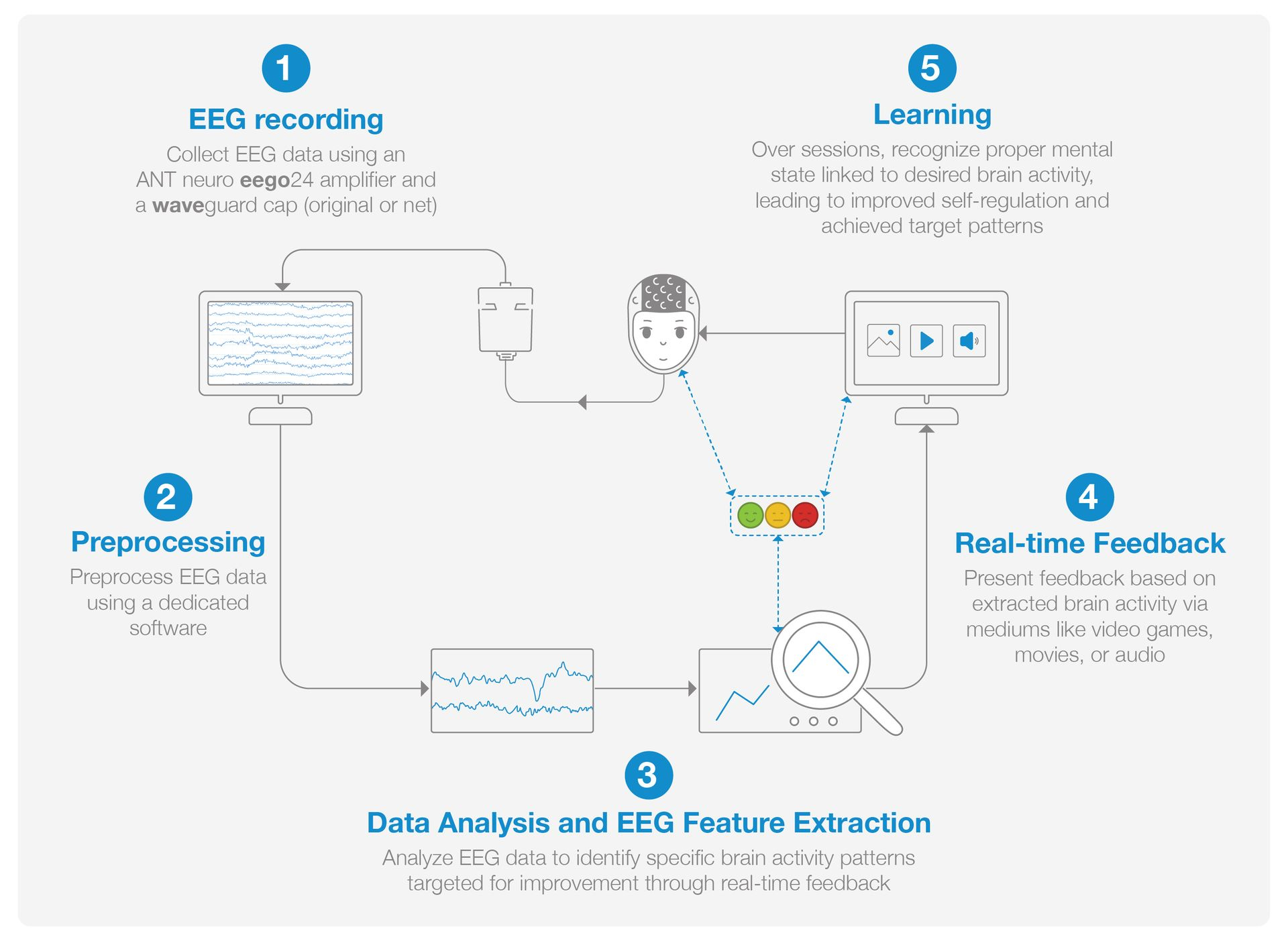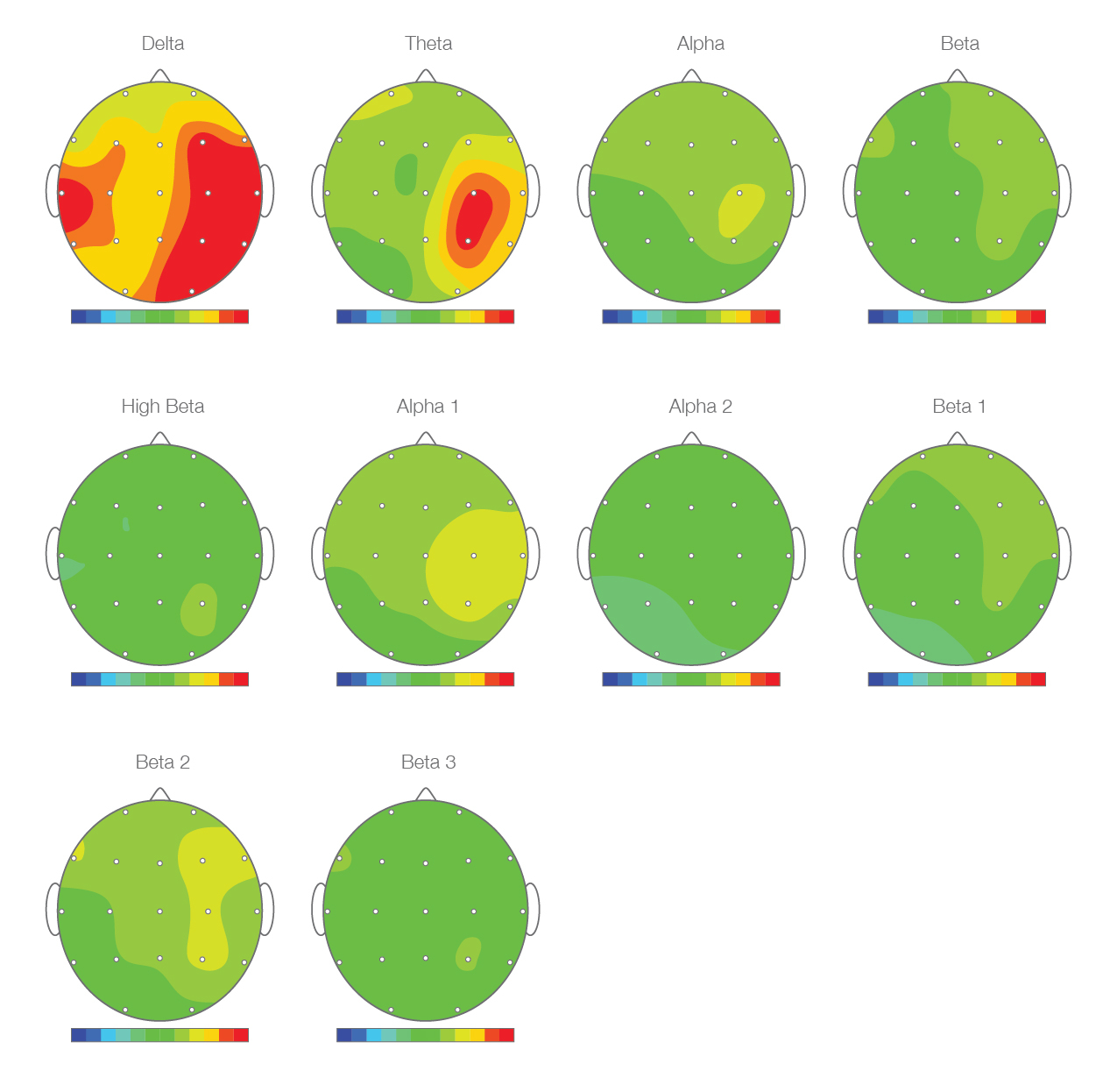With a history spanning over 60 years, neurofeedback has undergone rigorous scientific investigation. Recently, it has resurfaced as a tool to promote wellness and well-being supporting users toward a healthier lifestyle.
Over 60 years of research and application
With a history spanning over 60 years, neurofeedback has undergone rigorous scientific investigation. Recently, it has resurfaced as a tool to promote wellness and well-being supporting users toward a healtier lifestyle. This resurgence is attributed to its adaptable setup and methodology. Essentially, this form of “brain training” empowers individuals to self-regulate their brain’s activity patterns, fostering improved mental fitness and learning capabilities.
What is neurofeedback?
Neurofeedback is a special type of bio-feedback. The earliest form of this technology is rooted in electroencephalography (EEG), a method that captures brain activity and presents it in real-time on a computer screen. More recently, neurofeedback has garnered attention as a training approach for monitoring and supporting self-regulation of brain activities in real time. Neurofeedback is designed to gauge the brain’s electrical activity by identifying specific states (such as awake, asleep, attentive, relaxed, or stressed).
The data extracted from the EEG spectrum is then utilized to deliver real-time feedback to the individual, with positive reinforcement directed towards desired brain activities. To ensure optimal training outcomes, a comprehensive assessment is conducted before the training commences. This assessment, known as Quantitative Electroencephalogram (qEEG), benchmarks an individual’s brain activity across various states against a standardized normative database. The data derived from this assessment serves as the foundation for personalized training. Subsequently, this recorded and identified brain activity is implemented for the training process, empowering the individual to learn self-regulation of brain patterns through immediate, real-time feedback [1,2]
In this regard, neurofeedback is also defined as a closed-loop application in which a sensory representation (e.g., visual, auditory, tactile, multi-modal) of the brain activity is fed back to the user in real-time with the goal of assisting self-regulation of brain activities3. Therefore, based on the principle of operant conditioning, the brain is trained to achieve an optimal functioning by reinforcing desired states with positive feedback. For example, if the individual is feeling stressed, the training allows the individual to manage stress better. In a similar way, if the individual manifests concentration issues, the training may help improving “mental acuity” and focus. Being a closed-loop system, neurofeedback based on EEG is built across 5 steps [3] (Figure 1).
1. Data acquisition: the acquisition of brain activities is performed using EEG.
2. Online data preprocessing: artifacts are detected from the acquired EEG signal and corrected or rejected.
3. Feature-extraction: at this stage, interesting features are derived from the obtained signal. These features represent the specific pattern of brain activity that is targeted for modulation.
4. Generation of feedback signal: the extracted feature (e.g., alpha wave) is converted into a sensory representation (e.g., visual or auditory stimulus) presented to and processed by the learner. The feedback signal indicates the target activity state in relation to a specific threshold. Moreover, in this stage, the training process is enhanced by involving engaging activities like video games, music listening, and movie watching. More sophisticated applications, such as dynamic game controllers (with tactile feedback), can also be used. These training activities are aimed at incentivizing the brain to attain the targeted activity, ultimately leading to improved and self-regulated performance.
5. Learning process: Similar to a feedback loop system, the user is actively engaged, consistently applying and adjusting strategies to modify their brain activity in the intended direction and training goal.

Figure 1: Neurofeedback explained in 5 steps
Learn more about your brain through brain maps
But what makes this method unique, personalized, and precise? The integration of neurofeedback and qEEG [4,5], a method within brain mapping techniques, ensures a tailored and effective neurofeedback training plan by allowing a deeper understanding of brainwave patterns across different brain areas. Moreover, across multiple sessions, it is then possible to accurately gauge the effectiveness of the training and track training progress.
A correctly acquired EEG signal (e.g., from 19 channels) is analyzed using a dedicated software that employs various numerical and statistical methods. This approach aims to assess brain performance by measuring power similarly, communication speed, and consistency across regions, and by comparing an individual’s brainwave pattern with a standardized normative group. Typically, to ensure precise comparisons, a normative database is employed for this purpose. Moreover, the collected EEG data are plotted and visualized as brain maps, where the color coding indicates deviation from the normal activity range according to a Z-scored analysis. Alternatively, brain maps can be obtained from an individual’s brainwave pattern and visualized without requiring comparison to a normative EEG database.
Furthermore, the application of qEEG and brain maps extends beyond the scope of pre- and post-neurofeedback training assessment. Indeed, it can potentially support the investigation and analysis of certain medical conditions. In this regard, the major role of qEEG is not to obtain an immediate diagnosis but to provide an additional overview of the problem under investigation. Thus, in combination with other clinical and medical evaluations, it aims at gaining insights and proper understanding necessary for a detailed evaluation and assessment [6].
In summary, the key advantages of brain mapping through qEEG analysis include:
• Accurate visualization of brainwave activities for tailoring a personalized training plan;
• Assessment of training effects (e.g., pre-, post-training);
• Adjustment of training plans;
• Combined with other diagnostic tools for a complete evaluation and assessment.

Figure 2: Visual representation of brain maps based on Z-Score analysis
Rewire your brain activity with neurofeedback training
After the initial brain map analysis, the training plan is defined to assist self-regulation of an individual’s brain activity, in line with the training goal. Typically, each training session has a duration between 40 to 60 minutes and the length of the training may vary based on the individual’s brain fitness and specific training goal. For certain cases, 5-15 sessions might be adequate to attain the training objective, whereas other cases could demand a minimum of 10-15 sessions to observe notable benefits, with up to 40 sessions potentially necessary for achieving optimal and lasting results [7]. At the same time, also the frequency of training sessions (e.g., 1 - 2 sessions per week) is also considered to potentially achieve promising results [8].
Versatile and mobile
Neurofeedback’s versatility makes it applicable in various scenarios, assisting users in achieving well-being and a healthier lifestyle.
Ideal for:
• Private and public practices
• Medical clinics and healthcare facilities
• Wellness centers and programs
• Research institutes and educational establishments
• Other organizations, corporations, and initiatives advocating for health
All that’s required are a mobile eego mini amplifier, waveguard EEG cap with EEG accessories, and a dedicated software.
Designed to promote wellness and well-being
Neurofeedback based on brain maps can be an ideal approach for several applications sharing the common goal of achieving higher brain fitness and optimal functioning through a non-invasive and engaging approach. Three are the major fields and practices in which neurofeedback is currently applied [3]:
Training tool: as a training tool assisting self-regulation of an individual’ brain activity to promote wellness and well-being.
Peak performance: as a so-called “peak-performance training” to help improving “mental acuity”, learning and focus in healthy individuals.
Experimental approach: as an experimental method to investigate the causal role of specific neural events (such as neural oscillations) for cognition and behavior.
In general, the most common neurofeedback applications are reported below.
Wellness and well-being goals:
• Sleep habits management
• Stress management
• Coping skills management
• Relaxation
• Calmness
• Confidence and self-esteem support
Performance applications:
• Focus
• Creativity
• Mental acuity
• Learning capacities
• Performance management
Start neurofeedback today with the latest technology in the field
Start today with implementing brain map-based neurofeedback to cultivate health and wellness! You can connect with one of our specialists to explore the innovative neurofeedback solutions of ANT Neuro.
Feel free to contact us

Review of the therapeutic neurofeedback method using electroencephalography: EEG Neurofeedback
Omejc, N., Rojc, B., Battaglini, P. P., & Marusic, U.
Read More

Brain enhancement through cognitive training: a new insight from brain connectome
Taya, F., Sun, Y., Babiloni, F., Thakor, N., & Bezerianos, A.
Read More

EEG-Neurofeedback as a Tool to Modulate Cognition and Behavior: A Review Tutorial
Enriquez-Geppert, S., Huster, R. J., & Herrmann, C. S.
Read More

History of the scientific standards of QEEG normative databases
Thatcher, R. W., & Lubar, J. F.
Read More



Session Frequency Matters in Neurofeedback Training of Athletes
Domingos C, Peralta M, Prazeres P, Nan W, Rosa A, Pereira JG.
Read More